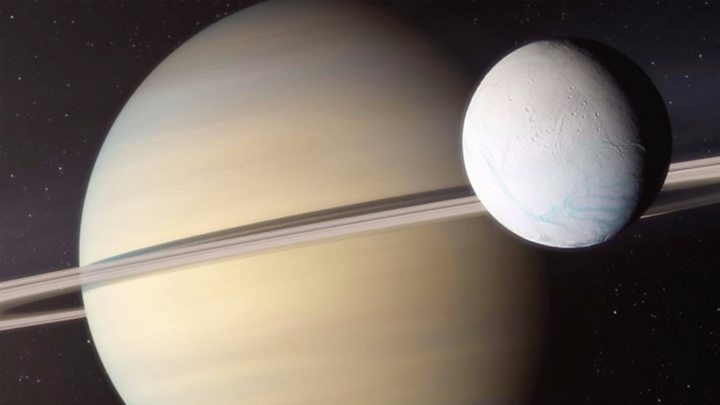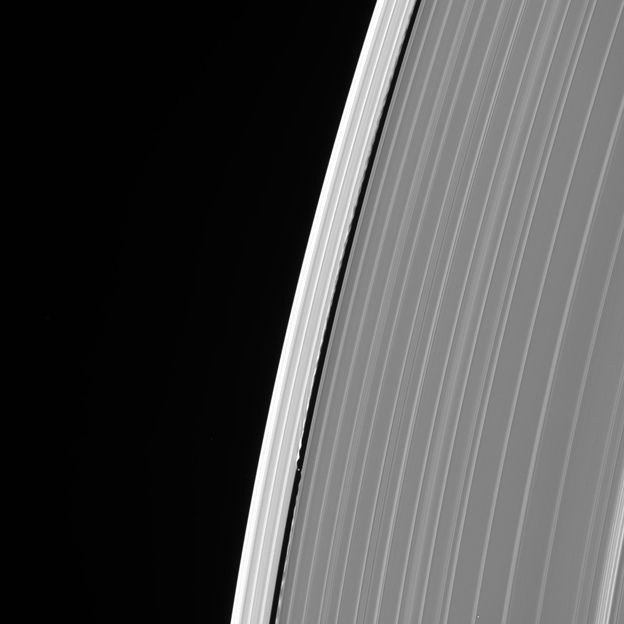Cassini: Probe incinerates on entry to Saturn
The American-led Cassini space mission to Saturn has just come to a spectacular end.
Controllers had commanded the probe to destroy itself by plunging into the planet's atmosphere.
It survived for just over a minute before being broken apart.
Cassini had run out of fuel and Nasa had determined that the probe should not be allowed simply to wander uncontrolled among Saturn and its moons.
The loss of signal from the spacecraft occurred pretty close to the prediction. Here at mission control, at the Jet Propulsion Laboratory (JPL) in Pasadena, California, the drop-off was timed at 04:55 PDT (11:55 GMT; 12:55 BST).
Nasa's Earl Maize addressed fellow controllers: "Congratulations to you all. This has been an incredible mission, an incredible spacecraft and you're all an incredible team. I'm going to call this the end of mission. Project manager off the net."
The statement brought restrained applause and some comforting embraces.
The loss of signal indicated that the probe was tumbling wildly in the planet's gases. Travelling downwards at over 120,000km/h, it could have survived the violence for no more than about 45 seconds before being torn to pieces.
Incineration in the heat and pressure of the plunge was inevitable - but Cassini still managed to despatch home some novel data on the chemical composition of Saturn's atmosphere.
Cassini: A mission of 'astonishing discovery'
- Meet the people who made Cassini happen
- In Pictures: Cassini probe's greatest shots
- What were the mission's biggest findings?
And so ends one of the most successful space missions in history.
In its thirteen years at Saturn, Cassini has transformed our understanding of the sixth planet from the Sun.
It has watched monster storms encircle the globe; it witnessed the delicate interplay of ice particles move through the planet's complex ring system; and it revealed extraordinary new insights on the potential habitability of Saturn's moons.
Titan and Enceladus were the standout investigations.
The former is a bizarre place where liquid methane rains from an orange sky and runs into huge lakes. Cassini put a small European robot called Huygens on Titan's surface in 2005. It returned a remarkable image of pebbles that had been smoothed and rounded by the action of that flowing methane.
Cassini also spied what are presumed to be volcanoes that spew an icy slush and vast dunes made from a plastic-like sand.
On Enceladus, the observations were no less stunning.

 NASA
NASA
This moon was seen to spurt water vapour into space from cracks at its south pole. The H20 came from an ocean held beneath the icy shell of Enceladus.
When Cassini flew through the water plumes, it showed that conditions in the sub-surface ocean were very probably suitable for life.
Today, scientists are already talking about how they can go back with another, more capable probe to investigate this idea further.
 NASA/JPL-CALTECH/SSI/JASON MAJOR
NASA/JPL-CALTECH/SSI/JASON MAJOR
A great many of those researchers have been gathered this week at the nearby campus of the California Institute of Technology. They watched a feed from the control room at JPL on giant screens.
Jonathan Lunine, from Cornell University at Ithaca, New York, spoke for many when he said: "I feel sad but I've felt sad the whole week; we knew this was going happen. And Cassini performed exactly as she was supposed to and I bet there is some terrific data on the ground now about Saturn's atmosphere."
And Linda Spilker, the Nasa Cassini project scientist, added: "When I look back on the Cassini mission I see a mission that was running a 13-year marathon of scientific discovery. And this last orbit was just the last lap. And so we stood in celebration of successfully completing the race. And I know I stood there with a mixture of tears and applause."
Although the probe has gone its science lives on. It has acquired a huge amount of data that will keep researchers busy for decades to come. A lot of it has barely even been assessed.
"Linda Spliker and I were joking earlier that those last few seconds of the Cassini mission - our first 'taste' of the atmosphere of Saturn - might be a number of PhD theses for students to come," observed Michael Watkins, the director of JPL. "So, even in those last few seconds, it will continue its re-writing of the textbooks."
 NASA/JPL-CALTECH/SSI
NASA/JPL-CALTECH/SSI
Saturn's moons: The strange and the wonderful
 NASA/JPL-CALTECH/SSI
NASA/JPL-CALTECH/SSI
Cassini has photographed some of Saturn's 62 moons: the two-tone Iapetus (1)with its walnut-like equatorial ridge; Mimas (2), which has a giant crater that instantly makes everyone think of the "Death Star" from the Star Wars movies; Hyperion (3), which displays clusters of bizarre pock marks akin to a sponge or wasps' nest; Atlas (4), which resembles a flying saucer; the potato-like Prometheus (5); and Pan (6), which has a shape that would not look out of place in a ravioli dish.
 NASA/JPL-CALTECH/SS
NASA/JPL-CALTECH/SS NASA/JPL-CALTECH/SSI
NASA/JPL-CALTECH/SSI
The Cassini-Huygens mission is a joint endeavour of Nasa, and the European and Italian space agencies.
The BBC has plenty of coverage of the ending of the mission on both TV and radio. Inside Science ran a preview of the climax on Radio 4. A Horizon documentarywill also review the mission and the final hours in a special programme to be broadcast on Monday 18 September at 21:00 BST on BBC Two. And you can still watch the Sky At Night programme Cassini: The Gamechanger on the iPlayer.
Cassini-Huygens - in numbers
Mission to Saturn
7.9bn km
travelled since launch
6
named moons discovered
- 453,000 images taken
- 2.5 million commands executed
- 635GB of science data collected
- 3,948 science papers published
Jonathan.Amos-INTERNET@bbc.co.uk and follow me on Twitter: @BBCAmos







No comments
Post a Comment